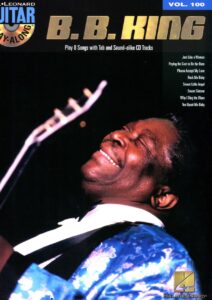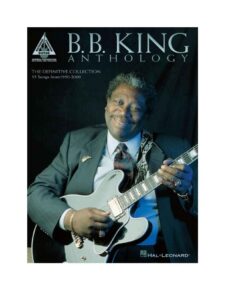Come join us now, and enjoy playing your beloved music and browse through great scores of every level and styles!
Can’t find the songbook you’re looking for? Please, email us at: sheetmusiclibrarypdf@gmail.com We’d like to help you!
Table of Contents
B.B. King Guitar Play Along Vol. 100 – with MP3 audio embedded sheet music pdf with Tablature

Best Sheet Music download from our Library.

Please, subscribe to our Library.
If you are already a subscriber, please, check our NEW SCORES’ page every month for new sheet music. THANK YOU!
Who was B.B. King?
B. B. King was born into a poor family in the Mississippi Delta on September 16, 1925 near a town called Itta Bena. The son of two land workers, Albert and Nora King, he was baptized Riley by his father’s brother. From that time she got the nickname Bibi (BB) because of the way her father called her younger brother (Baby Brother). Both his mother and grandmother were very religious people, so he regularly attended religious services in his community.

It was at Klimicheal Church where King had his first musical influences. The pastor used to use music to unify his congregation and the sound of his guitar fascinated the young King who learned from the pastor to play the strings of that instrument.
In Klimicheal, he got a job in the home of a white family, which allowed him to save money to buy his first guitar. At the beginning of 1943 he moved to Indianola (Mississippi Delta) where he quickly found work on the Johnson Barret plantation as a picker and tractor driver. In that city he formed his first group made up of five male voices, one was that of his cousin Birkett with whom he had sung in the church choir.

The group was called “The Famous St. John’s Gospel Singers” and King accompanied them on guitar as they sang in nearby churches. Some time later he left for Memphis with his guitar and a few dollars in his pocket. There he looked for his cousin Bukka White, whom he had last seen when the blues musician was visiting his family. Over the next ten months, his cousin schooled him in the art of the blues in private jam sessions. There, King learned everything from holding the guitar to how to make phrases. Thus, he began to earn a living as a musician, playing with other blues players in the area.
In Memphis he went to look for a disk jockey he met in Indianota: Sonny Boy. She convinced him to let her perform a song on his show. Sonny accepted and introduced him to the audience as a new talent… the radio received so many calls that Sonny immediately organized an event at one of the most prestigious venues in the area, Miss Annie’s Salon.
With the room packed, the success was absolute and the owner of the venue told Riley to continue coming to play, but under the condition that it be promoted on the radio. At that time the most important radio station for the black community was WDIA. Riley King went there to ask to be given a space. One of the owners of the station, Bert Ferguson, suggested that he could play whatever he wanted for ten minutes as long as he mentioned a tonic who had just become a sponsor. King’s line for the brand was: “Pepticon, Pepticon, it sure is good, You can get it in your neighborhood.”
The phrase became so popular that King was known as the “Pepticon Boy” and his show was called “Sepia Swing Club.” Now that he was famous, he needed a catchy name and that was when he remembered his uncle’s BB King, only he changed the meaning of the acronym and became “Blues Boy King” which was later shortened to B. B. King.
Now, being known, he could start recording and in 1949 he recorded his first album for Bullet Recording and Transcription Company. The record caught the attention of a larger company called Modern and in 1949, BB King signed a contract that lasted 10 years. In late 1949 he was performing at a small club in Arkansas when a fire started. When he reacted, his guitar was inside and he had to bravely go in and rescue it. Over time he learned that the fire started when a candlestick lamp was thrown to the floor because two men were fighting over a woman named Lucile. Since then, his guitar has been called Lucile.
1951 was ending and King’s seventh single, “Three O’Clock Blues”, a ballad composed by Lowell Fulson, entered Bill Board’s Rhythm and Blues charts very strongly. In January of the following year, the song was already number one on that list and held that position for 15 consecutive weeks. That success allowed him to negotiate a contract with Universal Artists of New York that guaranteed him performances in the best venues in Washington, Baltimore and the famous Apollo theater in Harlem. The appearance of rock and roll made many black musicians such as Little Richard, Fats Domino, James Brown or Chuck Berry become stars, somewhat softening racial barriers.
Perhaps favored by this, in 1969 he had his first appearance on television when Johnny Carson invited him to the “Tonight Show” and two years later, in 1971, he appeared on Ed Sullivan’s program, one of the most watched in the United States. In the late 80s, the group U2 asked BB King to record a song with them for the album “Rattle and Hum”, which gave him the opportunity for his music to be appreciated by a younger audience. For more than sixty years on the road, B. B. King has received nearly 20 Grammys, been inducted into the Rock and Roll Hall of Fame, received the United States Presidential Medal of Arts, and been honored by the Kennedy Center. . In the early 90s he opened his own club in Memphis and in 2000 he opened a bar in New York.
The passing of B. B. King in 2015 shook the hearts and musical memories of all of us on this planet who love black music. With him went one of the great creators and founders of the blues, a musician who created a new language with the electric guitar and who elevated the blues genre to the top, providing this genre with the essential support for everything that came later in the world. popular music of the 20th century.
With B. B. King, he became more than just a musician. Because B. B. King, who died at the age of 89, represented a way of life and musical creation in the United States and an unmatched way of playing live even in the precarious health conditions of recent times. When BB King went on stage something extraordinary always happened and his enormous ability to connect with the audience, his overwhelming strength live and his talent on the guitar were some of his qualities that accompanied him throughout his life.
Live At The Regal – B.B. KING (Full Album 1964)
TrackList
1.Everyday I Have The Blues 2.Sweet Little Angel 3.It’s My Own Fault 4.How Blue Can You Get? 5.Please Love Me 6.You Upset Me Baby 7.Worry, Worry 8.Woke Up This Mornin’ 9.You Done Lost Your Good Thing Now 10.Help The Poor
Personnel
- B.B. King – guitar, vocals
- Leo Lauchie – bass
- Duke Jethro – piano
- Sonny Freeman – drums
- Bobby Forte, Johnny Board – tenor saxophone
- Kenny “Kenneth” Sands – trumpet
- E. Rodney Jones, Pervis Spann – presenters
Technical
- Ron Steele Sr. – recording engineer
- Don Bronstein – cover
Live at the Regal is a 1965 live album by American blues guitarist and singer B.B. King. It was recorded on November 21, 1964, at the Regal Theater in Chicago. The album is widely heralded as one of the greatest blues albums ever recorded and was ranked at number 141 in Rolling Stone’s 2003 edition of the 500 Greatest Albums of All Time list, before dropping to number 299 in a 2020 revision.
In 2005, Live at the Regal was selected for permanent preservation in the National Recording Registry at the Library of Congress in the United States.
Carlos Santana, Eric Clapton, John Mayer and Mark Knopfler are among musicians who have used the album as a primer before performances.
The album was included in Robert Christgau’s “Basic Record Library” of 1950s and 1960s recordings—published in Christgau’s Record Guide: Rock Albums of the Seventies (1981)—and in Robert Dimery’s 1001 Albums You Must Hear Before You Die.
It was voted number 604 in Colin Larkin’s All Time Top 1000 Albums 3rd Edition (2000). In the same book it was number 6 in the Top 50 Blues albums of All-Time.
Live at the Regal was recorded on November 21, 1964, at the Regal Theater in Chicago, a venue King claimed to have played at “hundreds of times before”.
Browse in the Library:
Or browse in the categories menus & download the Library Catalog PDF:
